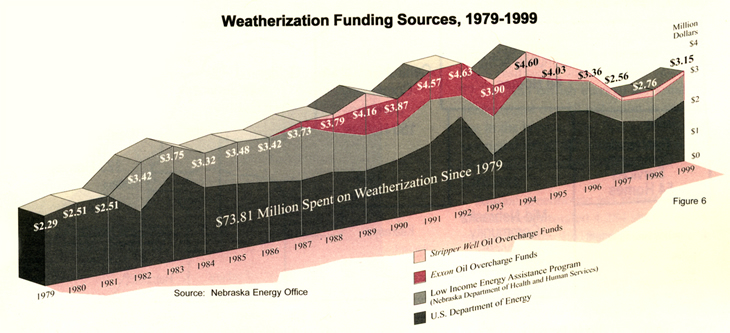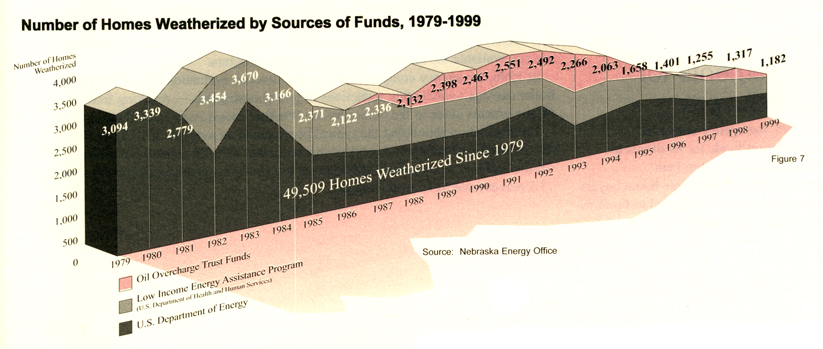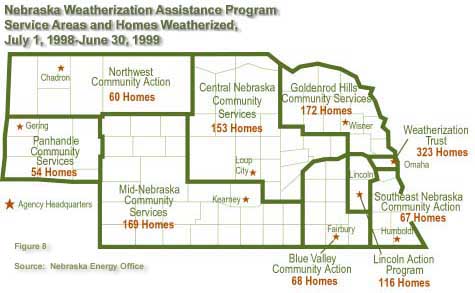 |
The Weatherization Division administers the Low Income Weatherization Assistance Program - a federally-funded program for weatherizing homes to save money and energy.
The Energy Office is responsible for inspecting about 23 percent of the homes - about 280 - that are weatherized and for monitoring and auditing the subgrantees, primarily community action agencies, that actually make the home weatherization improvements.
In 1998-1999, total funding for the program was $3,155,438. The U.S. Department of Energy's Low Income Weatherization Assistance Program provided a total of $1,917,284 and the Low Income Home Energy Assistance Program, administered through the Nebraska Department of Health and Human Services, supplied a total of $1,099,030. The balance of the funding - $139,124 - came from the Stripper Well oil overcharge trust account. Figure 6 shows the funding amounts and sources since the program began in 1979.
20 Years of Helping Nebraskans
Since 1979, more than $73.81 million in federal and oil overcharge funds have been spent to weatherize the homes of low-income elderly, disabled and others. In the past 20 years, 49,509 homes have received free weatherization (see figure 7). However, an estimated 59,000 Nebraska homes remain eligible for this service.
Homes Weatherized in
1998-1999

A total of 1,182 homes were weatherized in fiscal year 1998-1999. In keeping with the Weatherization Division's priority to serve Nebraska's elderly community, the agency weatherized 379 elderly households, or more than 32 percent of all homes improved during this period.
The map, figure 8, shows the nine Weatherization Assistance Program service areas and the number of homes weatherized in each area from July 1, 1998, through June 30, 1999.
Home improvements made through the program saved Nebraskans a total of more than $169,026 in avoided energy costs during 1998-1999. The home improvements represent a one-time investment that most likely will yield a rate of return for at least twenty years.
Mortgage Supplements for Homebuyers
 |
These mortgages are limited to families with incomes ranging from $12,360 for single persons to $41,970 for a family of eight. The below-market-rate mortgages allow prospective home buyers to make necessary energy-saving home improvements without raising the cost of the monthly mortgage payment.
Funds to capitalize the Weatherization Energy Efficiency Mortgages came from two sources: $100,000 from funds for Weatherization Assistance Program Landlord Loans - $50,000 from a 1991-1992 U.S. Department of Energy incentive grant and $50,000 in Exxon oil overcharge funds - and $58,823 from a one-time federal Department of Energy grant received in 1995-1996 that distributed previously uncommitted weatherization funds to the states.
To date, one loan for $3,070 has been made.
Energy savings resulting from weatherization improvements can mount dramatically since many of the improvements can last 15 to 20 years and longer. Figure 9, chronicles the estimated dollar savings resulting from home improvements made from 1986 through 1999 and total in excess of $34.85 million. Based on earlier studies, each home saves about $152 a year, primarily from heating costs, after the weatherization improvements have been made.
As one would expect, the most money has accrued from improvements made in the late 1980s - $4.5 million in 1986 and $4.6 million in 1987. Energy savings estimates are not available for the first seven years of the program.
|
|
The evaluation found that the typical home saved an average of 18.7 percent on energy used for heating and resulted in a reduction of $126 annually in utility bills. A similar national study using 1989 information showed annual average energy savings of 13.5 percent and $116 in each home.
The 1996 Nebraska findings range from 50 to nearly 100 percent higher than the 1989 national average for energy savings. Because the cost of energy in Nebraska is cheaper than many other areas of the nation, average dollar savings are only 15 percent above the national average.
The typical home's emissions savings, resulting from reduced energy use, averaged 2,297 pounds of carbon dioxide, less than one-half pound of sulfur dioxide and nearly 3/4 of a pound of nitrogen oxides.
Aggregate savings from the 3,700-plus homes improved in the two years of the study resulted in annual energy savings of 77.5 trillion British thermal units and an 18.7 percent overall reduction in energy use in the homes. The first year's dollar savings from all the homes in the study from reduced energy bills totaled $468,064.
Annual greenhouse gas reductions for all the houses totaled 4,284 short tons of carbon dioxide, 1,619 pounds of sulfur dioxide and 2,627 pounds of nitrogen oxides. The evaluation was conducted on a sample of homes that received free weatherization services in 1993 through 1995.